诗经《七月》详细教案
- 格式:doc
- 大小:65.50 KB
- 文档页数:9
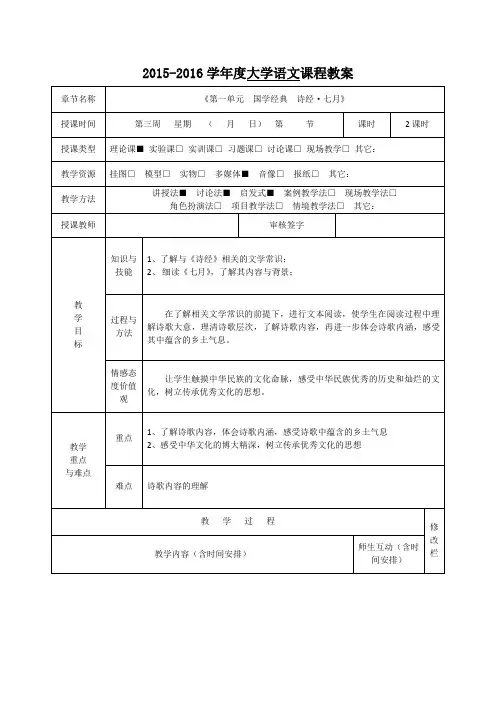
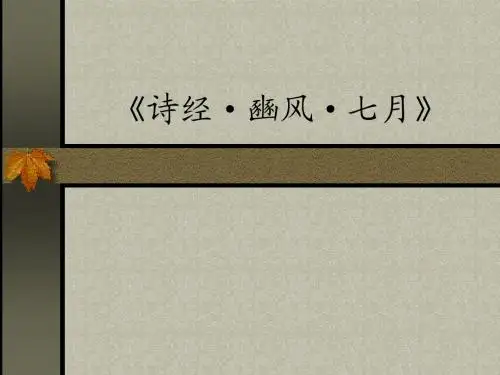
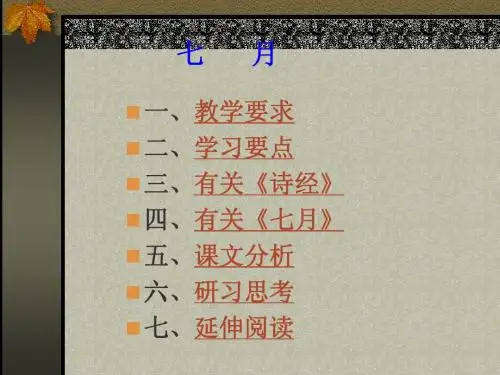
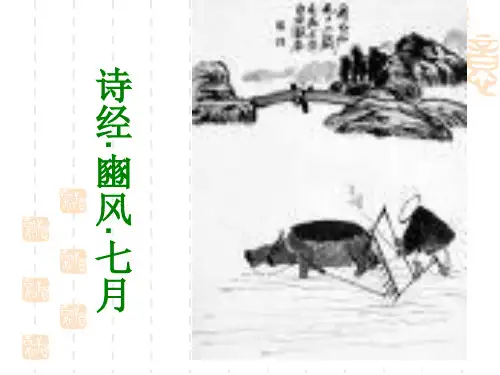
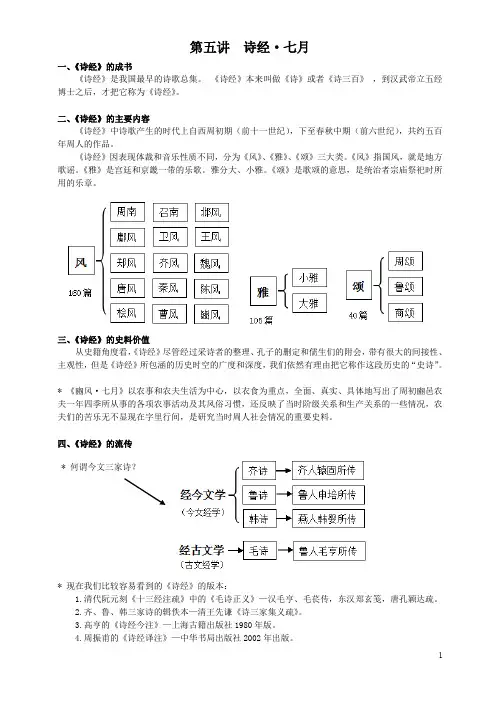
第五讲诗经·七月一、《诗经》的成书《诗经》是我国最早的诗歌总集。
《诗经》本来叫做《诗》或者《诗三百》,到汉武帝立五经博士之后,才把它称为《诗经》。
二、《诗经》的主要内容《诗经》中诗歌产生的时代上自西周初期(前十一世纪),下至春秋中期(前六世纪),共约五百年周人的作品。
《诗经》因表现体裁和音乐性质不同,分为《风》、《雅》、《颂》三大类。
《风》指国风,就是地方歌谣。
《雅》是宫廷和京畿一带的乐歌。
雅分大、小雅。
《颂》是歌颂的意思,是统治者宗庙祭祀时所用的乐章。
三、《诗经》的史料价值从史籍角度看,《诗经》尽管经过采诗者的整理、孔子的删定和儒生们的附会,带有很大的间接性、主观性,但是《诗经》所包涵的历史时空的广度和深度,我们依然有理由把它称作这段历史的“史诗”。
* 《豳风·七月》以农事和农夫生活为中心,以衣食为重点,全面、真实、具体地写出了周初豳邑农夫一年四季所从事的各项农事活动及其风俗习惯,还反映了当时阶级关系和生产关系的一些情况,农夫们的苦乐无不显现在字里行间,是研究当时周人社会情况的重要史料。
四、《诗经》的流传* 何谓今文三家诗?* 现在我们比较容易看到的《诗经》的版本:1.清代阮元刻《十三经注疏》中的《毛诗正义》—汉毛亨、毛苌传,东汉郑玄笺,唐孔颖达疏。
2.齐、鲁、韩三家诗的辑佚本—清王先谦《诗三家集义疏》。
3.高亨的《诗经今注》—上海古籍出版社1980年版。
4.周振甫的《诗经译注》—中华书局出版社2002年出版。
【《豳风·七月》】本文选自《十三经注疏》本《毛诗正义·豳风》。
豳(bīn),亦作邠,商周地名。
《七月》八章八十八句,是《国风》中第一长篇农事诗。
全诗以四言为主,各章或为农夫所唱,或为农妇所咏,叙事、抒情相结合,民歌特点十分明显,是豳地农民的作品。
【夏商周三代历法的“三正”问题】月建子丑寅卯辰巳午未申酉戌亥周历正月二月三月四月五月六月七月八月九月十月十一月十二月春夏秋冬殷历十二月正月二月三月四月五月六月七月八月九月十月十二月冬春夏秋冬夏历十一月十二月正月二月三月四月五月六月七月八月九月十月冬春夏秋冬。
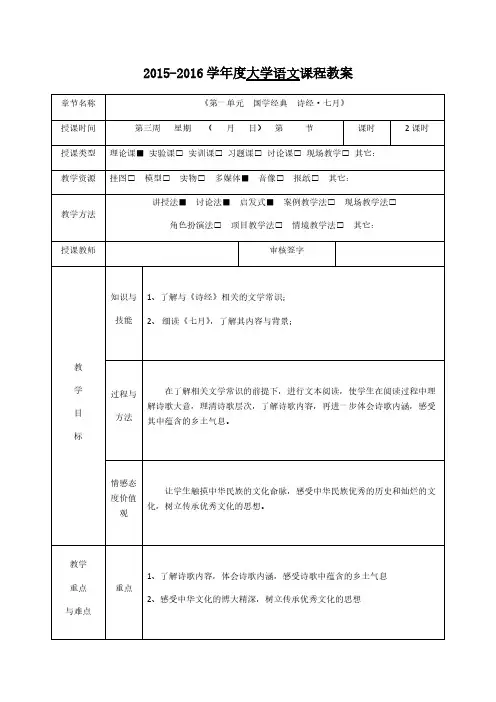
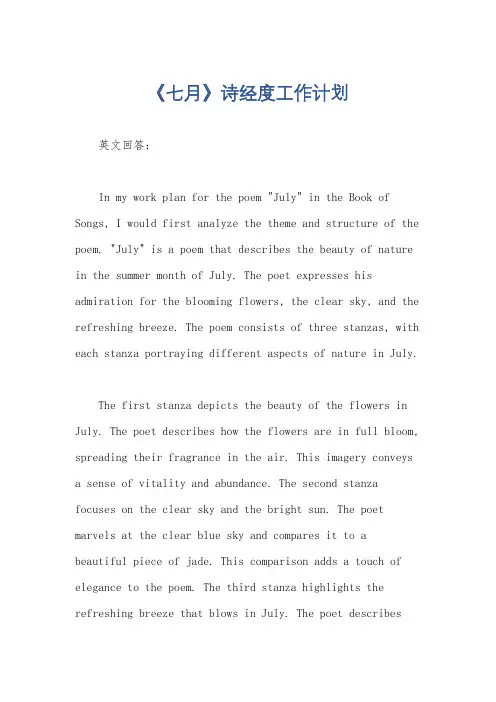
《七月》诗经度工作计划英文回答:In my work plan for the poem "July" in the Book of Songs, I would first analyze the theme and structure of the poem. "July" is a poem that describes the beauty of nature in the summer month of July. The poet expresses his admiration for the blooming flowers, the clear sky, and the refreshing breeze. The poem consists of three stanzas, with each stanza portraying different aspects of nature in July.The first stanza depicts the beauty of the flowers in July. The poet describes how the flowers are in full bloom, spreading their fragrance in the air. This imagery conveys a sense of vitality and abundance. The second stanza focuses on the clear sky and the bright sun. The poet marvels at the clear blue sky and compares it to abeautiful piece of jade. This comparison adds a touch of elegance to the poem. The third stanza highlights the refreshing breeze that blows in July. The poet describeshow the breeze brings relief from the heat and brings joyto people's hearts.Moving on to my work plan, I would then delve into the poetic devices used in the poem. The poet employs vivid imagery to paint a picture of the beauty of July. For example, in the first stanza, the poet uses the image of flowers in full bloom to evoke a sense of abundance and vitality. In the second stanza, the comparison of the clear sky to a piece of jade adds a touch of elegance to the poem. The use of personification is also evident in the poem, as the poet attributes human qualities to nature. For instance, the breeze is described as bringing joy to people's hearts.Furthermore, I would analyze the tone and mood of the poem. The tone of "July" is one of admiration and appreciation. The poet expresses his awe and wonder at the beauty of nature in July. The mood of the poem is uplifting and joyful, as the poet celebrates the beauty of the season.In terms of the cultural and historical context, "July" reflects the Chinese appreciation for nature and thechanging seasons. In Chinese culture, nature is often seen as a source of inspiration and a reflection of the human experience. The poem captures the essence of summer and portrays the beauty of nature during this time of the year.中文回答:《七月》是《诗经》中的一首诗,我在这篇工作计划中将对这首诗的主题和结构进行分析。
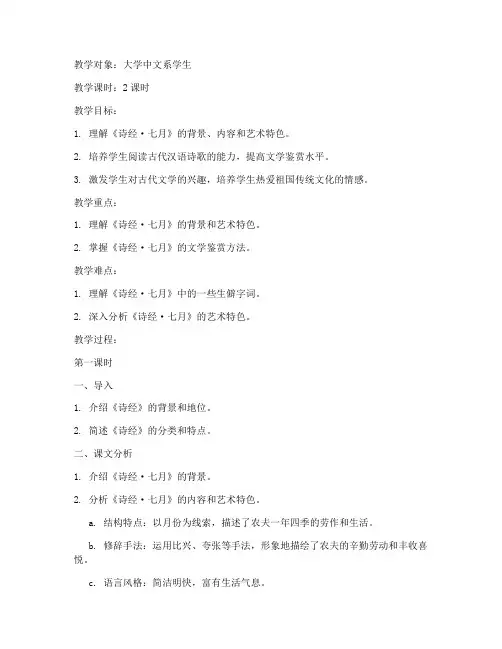
教学对象:大学中文系学生教学课时:2课时教学目标:1. 理解《诗经·七月》的背景、内容和艺术特色。
2. 培养学生阅读古代汉语诗歌的能力,提高文学鉴赏水平。
3. 激发学生对古代文学的兴趣,培养学生热爱祖国传统文化的情感。
教学重点:1. 理解《诗经·七月》的背景和艺术特色。
2. 掌握《诗经·七月》的文学鉴赏方法。
教学难点:1. 理解《诗经·七月》中的一些生僻字词。
2. 深入分析《诗经·七月》的艺术特色。
教学过程:第一课时一、导入1. 介绍《诗经》的背景和地位。
2. 简述《诗经》的分类和特点。
二、课文分析1. 介绍《诗经·七月》的背景。
2. 分析《诗经·七月》的内容和艺术特色。
a. 结构特点:以月份为线索,描述了农夫一年四季的劳作和生活。
b. 修辞手法:运用比兴、夸张等手法,形象地描绘了农夫的辛勤劳动和丰收喜悦。
c. 语言风格:简洁明快,富有生活气息。
三、课堂讨论1. 学生分组讨论,分析《诗经·七月》中的生僻字词。
2. 各组派代表分享讨论成果。
四、课堂小结1. 总结《诗经·七月》的背景、内容和艺术特色。
2. 强调阅读古代汉语诗歌的方法。
第二课时一、复习导入1. 回顾《诗经·七月》的背景、内容和艺术特色。
2. 提出问题:如何深入分析《诗经·七月》的艺术特色?二、课文分析1. 分析《诗经·七月》的艺术特色。
a. 比兴手法:如“七月流火,八月蟋蟀在堂”等,形象地描绘了季节变化。
b. 夸张手法:如“采采卷耳,不盈顷筐”等,生动地表现了农夫的辛勤劳作。
2. 分析《诗经·七月》中的生僻字词。
a. 举例说明生僻字词在诗中的运用。
b. 引导学生理解生僻字词的含义。
三、课堂讨论1. 学生分组讨论,分析《诗经·七月》中的比兴手法和夸张手法。
2. 各组派代表分享讨论成果。
四、课堂小结1. 总结《诗经·七月》的艺术特色。
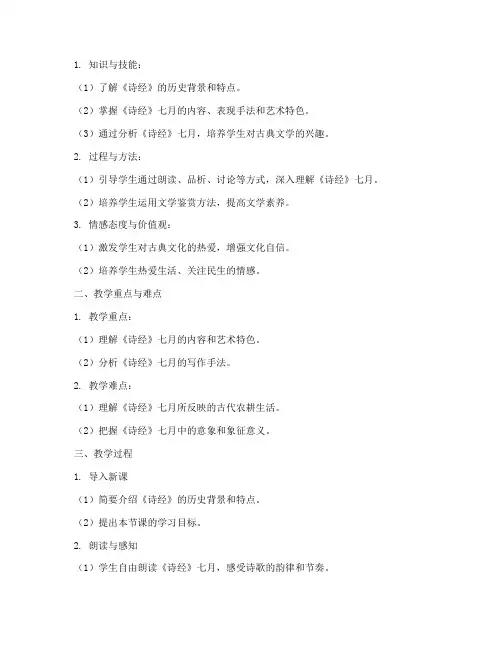
1. 知识与技能:(1)了解《诗经》的历史背景和特点。
(2)掌握《诗经》七月的内容、表现手法和艺术特色。
(3)通过分析《诗经》七月,培养学生对古典文学的兴趣。
2. 过程与方法:(1)引导学生通过朗读、品析、讨论等方式,深入理解《诗经》七月。
(2)培养学生运用文学鉴赏方法,提高文学素养。
3. 情感态度与价值观:(1)激发学生对古典文化的热爱,增强文化自信。
(2)培养学生热爱生活、关注民生的情感。
二、教学重点与难点1. 教学重点:(1)理解《诗经》七月的内容和艺术特色。
(2)分析《诗经》七月的写作手法。
2. 教学难点:(1)理解《诗经》七月所反映的古代农耕生活。
(2)把握《诗经》七月中的意象和象征意义。
三、教学过程1. 导入新课(1)简要介绍《诗经》的历史背景和特点。
(2)提出本节课的学习目标。
2. 朗读与感知(1)学生自由朗读《诗经》七月,感受诗歌的韵律和节奏。
(2)教师范读,引导学生体会诗歌的韵味。
3. 品析与讨论(1)学生分组讨论,分析《诗经》七月的内容、表现手法和艺术特色。
(2)教师总结各组讨论成果,强调重点和难点。
4. 分析与探究(1)引导学生分析《诗经》七月中的意象和象征意义。
(2)结合古代农耕生活,探讨诗歌所反映的社会现实。
5. 课堂小结(1)回顾本节课所学内容,总结《诗经》七月的特点和艺术价值。
(2)鼓励学生课后阅读更多《诗经》作品,拓展文学视野。
6. 课后作业(1)背诵《诗经》七月。
(2)结合所学知识,写一篇关于《诗经》七月的读后感。
四、教学评价1. 课堂表现:观察学生在课堂上的参与程度、发言积极性等。
2. 作业完成情况:检查学生背诵《诗经》七月的情况,以及读后感的质量。
3. 学生自评与互评:鼓励学生在课后进行自评和互评,提高文学鉴赏能力。

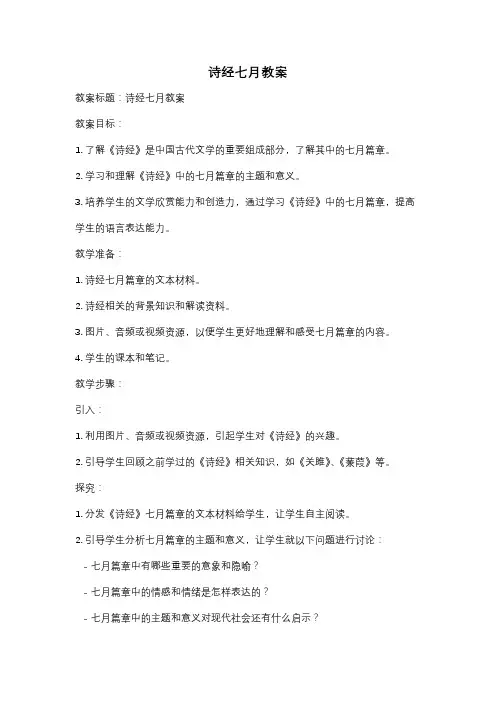
诗经七月教案教案标题:诗经七月教案教案目标:1. 了解《诗经》是中国古代文学的重要组成部分,了解其中的七月篇章。
2. 学习和理解《诗经》中的七月篇章的主题和意义。
3. 培养学生的文学欣赏能力和创造力,通过学习《诗经》中的七月篇章,提高学生的语言表达能力。
教学准备:1. 诗经七月篇章的文本材料。
2. 诗经相关的背景知识和解读资料。
3. 图片、音频或视频资源,以便学生更好地理解和感受七月篇章的内容。
4. 学生的课本和笔记。
教学步骤:引入:1. 利用图片、音频或视频资源,引起学生对《诗经》的兴趣。
2. 引导学生回顾之前学过的《诗经》相关知识,如《关雎》、《蒹葭》等。
探究:1. 分发《诗经》七月篇章的文本材料给学生,让学生自主阅读。
2. 引导学生分析七月篇章的主题和意义,让学生就以下问题进行讨论:- 七月篇章中有哪些重要的意象和隐喻?- 七月篇章中的情感和情绪是怎样表达的?- 七月篇章中的主题和意义对现代社会还有什么启示?拓展:1. 分组讨论:将学生分为小组,让他们选择一首七月篇章进行深入研究,并就以下问题展开讨论:- 这首诗的主题和意义是什么?- 诗中使用了哪些修辞手法和表现手法?- 这首诗对你有什么启发或感受?展示:1. 每个小组派代表向全班展示他们对所选诗的研究结果。
2. 全班共同讨论各组的展示内容,探讨不同的观点和理解。
巩固:1. 老师总结《诗经》七月篇章的主题和意义,并与学生一起总结所学内容。
2. 鼓励学生运用所学知识,创作一首自己的七月篇章,可以是诗歌、散文等形式。
作业:要求学生完成自己创作的七月篇章,并写下对《诗经》七月篇章的个人理解和感受。
评估:1. 对学生的课堂参与情况进行评估。
2. 对学生完成的创作和对《诗经》七月篇章的理解进行评估。
教学延伸:1. 鼓励学生继续研究和欣赏《诗经》中的其他篇章。
2. 组织学生参观相关的文化活动或展览,加深对《诗经》的理解和欣赏。
教学反思:教师根据学生的学习情况和反馈,对教案进行反思和调整,以提高教学效果。
国风·豳风·七月《··七月》是《》中的一首诗。
是一首的民歌。
此诗反映了周代早期的农业生产情况和农民的日常生活情况,不仅有重要的历史价值,也是一首杰出的叙事兼抒情的名诗。
全诗共分为八章。
第一章从岁寒写到春耕开始;第二章写妇女蚕桑;第三章写布帛衣料的制作;第四章写猎取野兽;第五章写一年将尽,为自己收拾屋子过冬;第六章写采藏果蔬和造酒,这都是为公家的,为自己采藏的食物是瓜瓠麻子苦菜之类;第七章写收成完毕后为公家做修屋或室内工作,然后修理自家的茅屋;末章写凿冰的劳动和一年一次的年终燕饮。
全诗围绕着一个“苦”字,按照季节的先后,从年初写到年终,从种田养蚕写到打猎凿冰,反映了一年四季多层次的工作面和高强度的劳动,语言朴实无华,完全是用铺叙的手法写成的,语调凄切清苦,仿佛是在哭吟着一部沉重的历史。
七月流火,九月授衣。
一之日觱发,二之日栗烈。
无衣无褐,何以卒岁。
三之日于耜,四之日举趾。
同我妇子,馌彼南亩,田畯至喜。
七月流火,九月授衣。
春日载阳,有鸣仓庚。
女执懿筐,遵彼微行,爰求柔桑。
春日迟迟,采蘩祁祁。
女心伤悲,殆及公子同归。
七月流火,八月萑苇。
蚕月条桑,取彼斧斨,以伐远扬,猗彼女桑。
七月鸣鵙,八月载绩。
载玄载黄,我朱孔阳,为公子裳。
四月秀葽,五月鸣蜩。
八月其获,十月陨箨。
一之日于貉,取彼狐狸,为公子裘。
二之日其同,载缵武功,言私其豵,献豜于公。
五月斯螽动股,六月莎鸡振羽,七月在野,八月在宇,九月在户,十月蟋蟀入我床下。
穹窒熏鼠,塞向墐户。
嗟我妇子,曰为改岁,入此室处。
六月食郁及薁,七月亨葵及菽,八月剥枣,十月获稻,为此春酒,以介眉寿。
七月食瓜,八月断壶,九月叔苴,采茶薪樗,食我农夫。
九月筑场圃,十月纳禾稼。
黍稷重穋,禾麻菽麦。
嗟我农夫,我稼既同,上入执宫功。
昼尔于茅,宵尔索綯。
亟其乘屋,其始播百谷。
二之日凿冰冲冲,三之日纳于凌阴。
四之日其蚤,献羔祭韭。
九月肃霜,十月涤场。